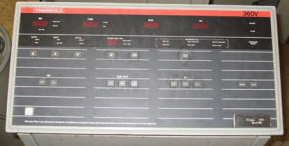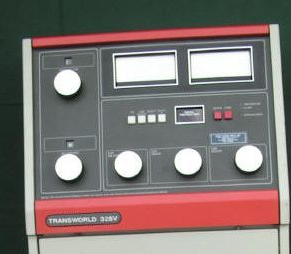The following is some information from 35+ years of doing this type of work
For parts, click on the parts tab above in the header
For Service Manuals go to manuals or click here
For parts, click on the parts tab above in the header
For Service Manuals go to manuals or click here
The X-Ray Parts Depot Technician Tips Page
Transworld 360 kV adjust. This is an overall kV adjust. It will increase or decrease the kV on all mA stations at the same time. It does not change the kV display, but rather the output itself. This is a step beyond the line tap settings. This info will tell you how to adjust. No parts supplied or needed. This was never mentioned in the service manual. We supply the kV adjust info with the service manual download. Also included is our generator to transformer interconnect table/diagram.
Universal Easymatic 325 and Unimatic 325, intermittent, preps, but no exposure. The time delay relay was infamous for causing this problem. The module is $ 265 + shipping. Also check line voltage/auto tap settings.
De-select any buckys when troubleshooting this problem. Also check line voltage tap settings. Click here for the parts
For troubleshooting tips of the Uni-Matic model 3487 with the digital timer board,click this link
De-select any buckys when troubleshooting this problem. Also check line voltage tap settings. Click here for the parts
Erratic kV meter and output, but completes exposure? Check the kV comp board on Uni-matic's. Also kV tap switches.
Summit generators, Nova 325/360 and Innovet (the original, model W300 generator). Intermittent, preps but no exposure. Always check the footswitch first on the Innovets or any generator with a footswitch. The motor start board, A455, had issues from time to time. We have repaired boards. The board is available with exchange of your old board.
De-select any buckys when troubleshooting for the these problems. For Summit parts Click here
Completes exposure, but intermittent output? Check filament, hi-tension cable end/pins, mA selector switch and kV tap switches. May also be a faulty timer board. For more information, click here for the Advanced Troublehsooting Page.Tingle TXR 325D, etc. generators doesn't always prep or give a ready. Check rotor starter p.c.b and that the red LED is lighting on the rotor control p.c.b after about a 2 second delay. If not, about +90% bad rotor starter bd.
The kV display is erratic, changes in set value, displays a "1" intermittently or all the time. Bad kV display board.
Generator seems normal including the sonalert beep, but intermittently or constant problem of no radiation output. May be loss of filament or a faulty timer p.c. board. Either one can give the same symptom.
Majority of the time it will be a faulty timer board.
For Tingle parts click here Click here
Universal/Gendex Hi-frequency generators with intermittent prep/rotor exposure problems. The prep/expose switches will fail intermittently. You can either replace the switches or wire in a remote handswitch for troubleshooting purposes. The I/O board in the generator also had it's issues over the years resulting in an intermittent no ready. Also check that the main contactor is pulling in, in a solid manner. If the contactor does not fully pull in each time on power-up, it can give intermittent prep/ready issues as the cap bank may not charge. The I/O board though many times, was the cause. That being said we have had a number of I/O board orders recently from third party parts suppliers requesting another replacement I/O and what we sent was DOA. This has not been the case. Our boards are tested before shipping. If you have rotor and no ready with a replacement I/O board, the I/O board is NOT the problem. Check the prep switch again and all of the tube rotor circuit. If ok, suspect a bad mA/rotor board. If it's bad it can give the same symptom. Click here for parts
For troubleshooting ATC/AP or MP500/GX generators, click here
Bennett/Trex/HCMI generators Hi-freq HFQ/HF go to the Advanced troubleshooting pageClick here



Transworld 325 intermittently will rotor/prep but not expose. Most common failure was the power supply board. The part is listed on our Transworld parts page. The service manual for this generator is listed on our Transworld service manual page.
If there is any type of digital system hard wired to any X-Ray generator always first determine that the digital add-on is not causing any problems. There are situations where they fail sending a person in the wrong direction for troubleshooting
Always check the voltage of the cap bank on any hi-freq generator that has one. As caps get age on them they can change in value dramatically and then the DC rail voltage drops.
With the generator turned on, sitting idle, these are approximate:
Universal, Gendex or Del - about 380 vdc on the dc rail across the copper strips
Bennett HFQ or HCMI - about 345 to 380 vdc on either the left or right hand cap bank
Whatever the voltage is it should be within a few volts +/- between either side
All of our inverter/drivers are rebuilt with new capacitors as these caps can also fail
Newer, non-invasive test equipment versus older X-Ray generators as a problem
One other note, recently we've seen a number of instances where later model non invasive test equipment of various brands does not give a good or accurate indication of mAs, sometimes not even for mA on older generators. It may be able to give an approximation of mA but that doesn't help much where older standard freq and early vintage hi-freq generators were very dependent on very accurate readings of mAs for calibration. Sometimes there is no substitute for something such as an older Nuclear Associates or Fluke invasive mAs meter. Old school, but it's accurate.The kV measurements of newer test equipment does not seem to be a problem.
Old School list for down and dirty troubleshoting:
A non invasive test meter with a means to measure kV and exposure time
An invasive mAs meter, such as a Fluke 07-487
An old cassette screen that can be thrown under the collimator for a quick check of radiation output
A known good pair of hi-tension cables and a known good X-Ray tube (I don't agree with swapping cables on older systems)
Either a DZE or FCS collimator lamp for certain load tests
At least four, known good alligator jumper test leads
An auto ranging voltmeter/multimeter that has attachable alligator test clips for making no-hands measurements
(A meter with a manually selectable range is OK, just make sure you have the correct range selected)
If you carry these items for generator service calls, that's about half the battle
I wouldn't go on a generator service call without the above
*One important note, the proper way to check a fuse is with removed from the fuse holder! Left in the fuse holder can give
erroneous indication from other things in the circuit.